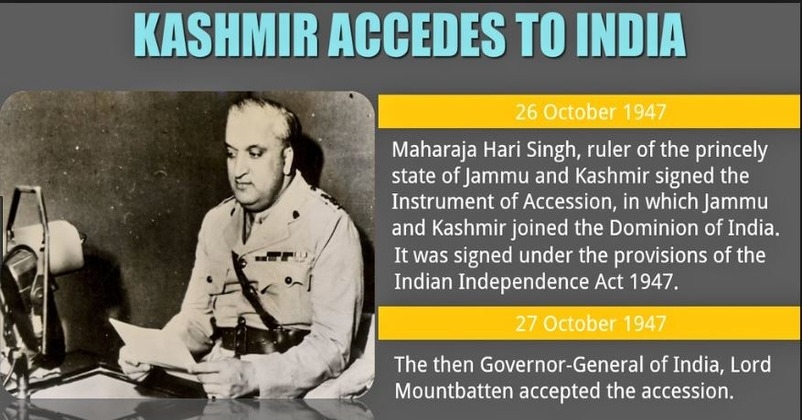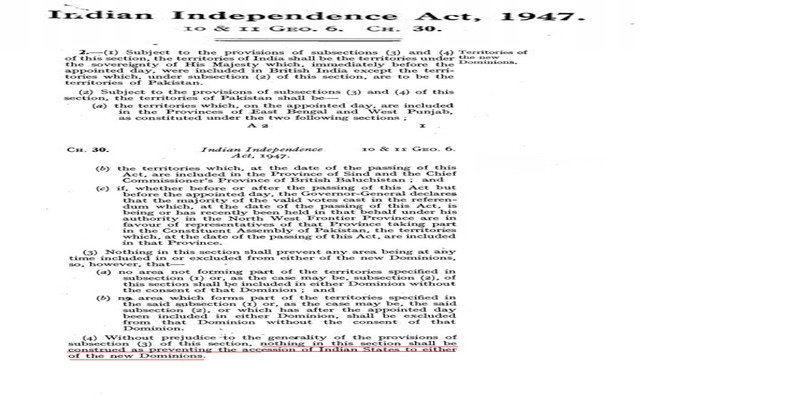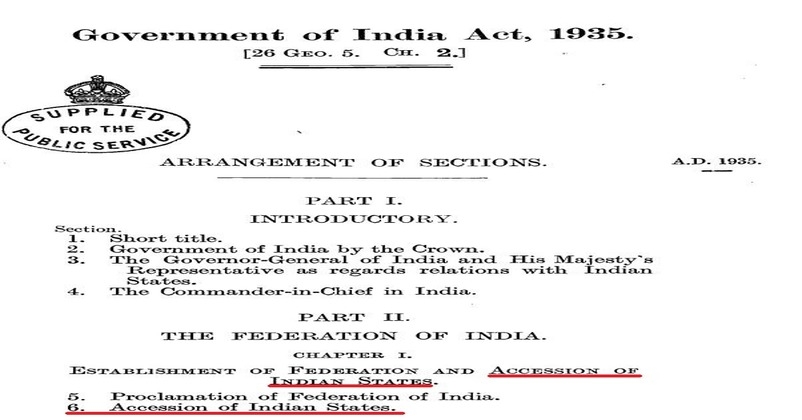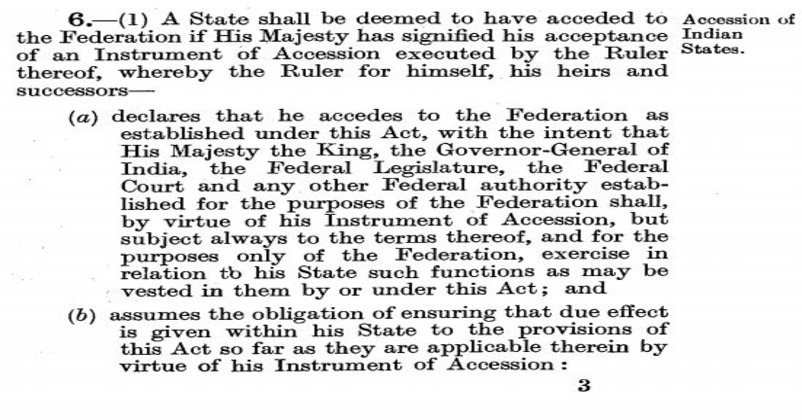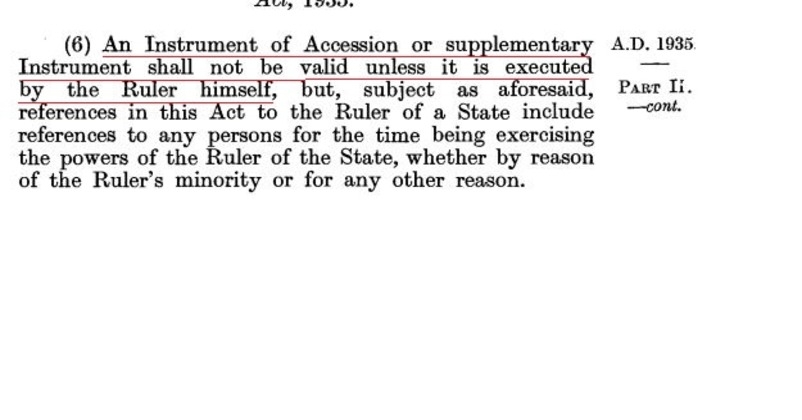Many people create confusion about the accession of Jammu and Kashmir to India. They said that Maharaja Hari Singh had three options viz. accede to India or accede to Pakistan or to remain independent. But the first two options were very well available with the rulers of the Princely States i.e. accede either to India or to Pakistan. However, there was no third option i.e. to remain independent. Even the cursory look at the Memorandum of British Cabinet Mission that was presented to the Chancellor of Chamber of Princes in India (Nawab of Bhopal) on May 12, 1946 by Lord Pethick-Lawrence, the British Secretary of State for India and the subsequent application of Indian Independence Act and the Government of India Act makes it amply clear that the all the rulers of the Princely States, including Jammu and Kashmir have two options i.e. either to accede to India or to Pakistan and that option has to be exercised solely by the rulers. It is important to note here that the Britishers had two types of administrative arrangements to govern India. First, was that they directly ruled over a large tract of land in India, which was identified as ‘British India’. The other administrative arrangement was with the rulers of the ‘Princely States’, in which the British entered into different treaties with the rulers. The number of these States were over 550 and they covered around 45% of the total geographical area of unified India. At the time of independence, the paramountcy of the British lapsed and the rulers were left with only two options i.e. either to accede to India or to Pakistan.
Memorandum on State Treaties and Paramountcy
The British Cabinet Mission, headed by Lord Pethick-Lawrence, the British Secretary of State for India, presented a Memorandum on 12-05-1946 to the Chancellor of Chamber of Princes in India (Nawab of Bhopal). The memorandum on State Treaties and Paramountcy discussed at length about the future of Princely States once the British paramountcy over the States lapses and the new dominion(s) come into being. With this memorandum, the near future of Princely States was slated. The important points mentioned in the memorandum were:
Para {2} of the memorandum mentions ‘that during the interim period, which must elapse before the coming into operation of a new constitutional structure under which British India will be independent or fully self-governing, paramountcy will remain in operation. But the British Government could not and will not in any circumstances transfer paramountcy to an Indian Government.’;
Para {4} of the memorandum states that ‘during the interim period it will be necessary for the States to conduct negotiations with British India in regard to the future regulation of matters of common concern, especially in the economic and financial field. Such negotiations, which will be necessary whether the States desire to participate in the new Indian Constitutional structure or not will occupy a considerable period of time. And since some of these negotiations may be incomplete when the new structure comes into being. it will, in order to avoid administrative difficulties, to arrive at an understanding between the States and those likely to control the successor Government or Governments that for a period of time the then existing arrangements as to these matters of common concern should continue until the new agreements are completed. In this matter, the British Government and the Crown Representative will lend such assistance as they can, should it be so desired and:
Para {5} said that ‘when a new fully self-governing or independent government or Governments come into being in British India, His Majesty’s Government ‘s influence with these Governments will not be such as to enable them to carry out the obligations of paramountcy. Moreover, they cannot contemplate that British troops would be retained in India for this purpose. Thus, as a logical sequence and in view of the desires expressed to them on behalf of the Indian States, His Majesty’s Government will cease to exercise the powers of paramountcy. This means that the rights of the States which flow from their relationship to the Crown will no longer exist and all the rights surrendered by the states to the paramount power will return to the States. Political arrangements between States on one side and the British Crown and British India on the other will thus be brought to an end. Keeping the spirit resting in the memorandum since Paramountcy was to practically lapse {as regards the British commitments on treaties} on 15-08-1947, the Princes were free to accede to one or the other dominion, Of course, the obligation of British to defend their boundaries was to lapse and not transfer. The void will have to be filled either by the States entering into a federal relationship with successor Government or Governments in British India, or failing this, entering into particular political arrangements with it or them.’
In this memorandum, Lord Pethick-Lawrence clearly stated that the Princes are free to accede to any of the dominions. He did not mention that the much-discussed about third option, i.e. to remain independent, was an option at all.
Indian Independence Act
Section 2 (4) of Indian Independence Act, 1947 mentions that “without prejudice to the generality of the provisions of subsection (3) of this section, nothing in this section shall be construed as preventing the accession of Indian States to either of the new Dominions.” The provision on accession has only been discussed in section 2 (4) of Indian Independence Act, where it is clearly mentioned that the Indian States will not be prevented from acceding to either of the new Dominions. It clearly mentions that the provision of remaining independent was not available with the Princely States. However, the bogey of lies has been created that Maharaja Hari Singh had the option of remaining independent whereas this option was not available with any Princely State, including Jammu and Kashmir.
Government of India Act, 1935
The provision of the Government of India Act was applicable in India until the country had adopted its own constitution. Under Chapter I of Part II of this Act the specific section on the accession of India states is given. As per Section 6 of this Act, the Instrument of Accession should be signed by the rulers himself otherwise it will not be considered valid, which clearly shows that ruler was the sole authority in deciding about the accession of any Princely state.
Even in the address of Crown Representative Lord Louis Mountbatten on July 25, 1947, he advised that the rulers accede to any of the dominions. Hence, it is amply clear that like any other Princely States, the State of Jammu and Kashmir had two options i.e. either to accede to India or to Pakistan. The third option was not available even in the case of Jammu and Kashmir. Also, Maharaja Hari Singh of Jammu and Kashmir was the only legal authority to decide the future course of action with respect to the state. He acceded to India and Jammu and Kashmir became the 15th state of Union of India.
